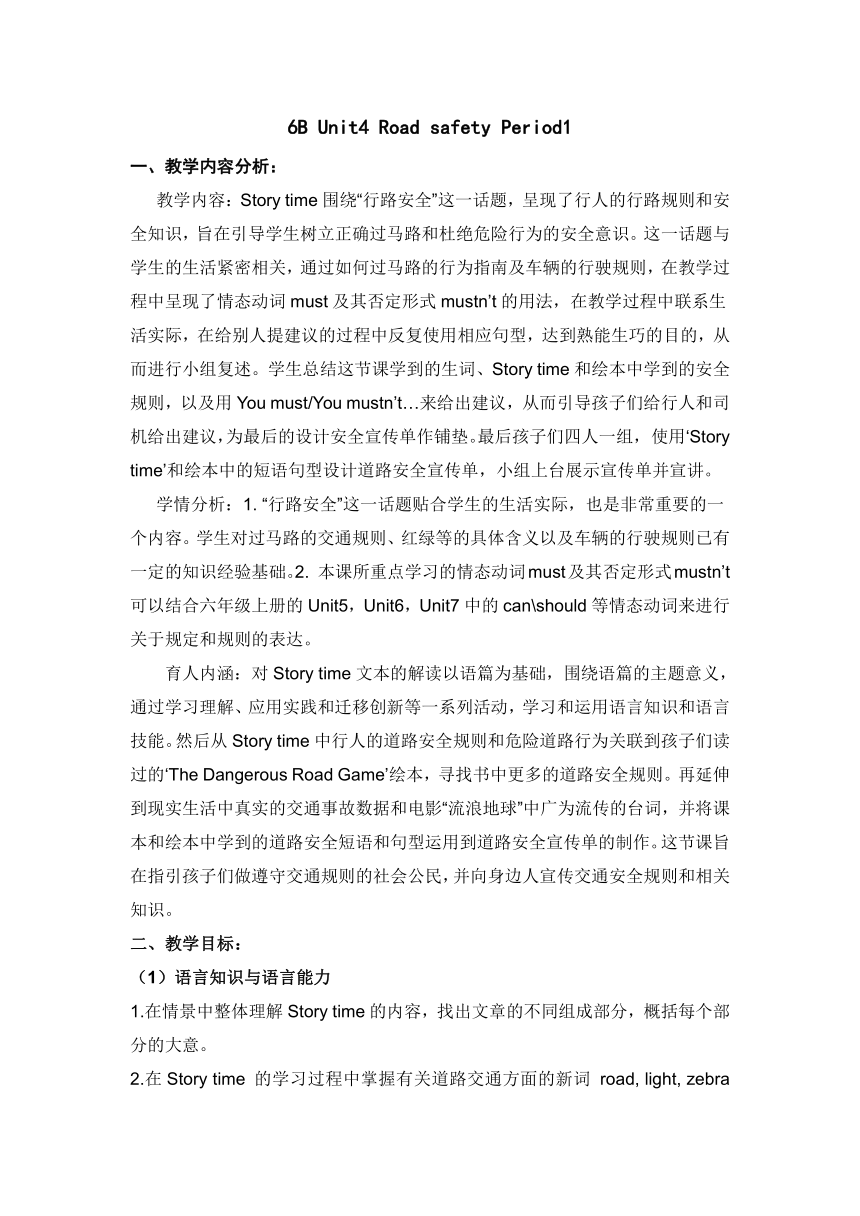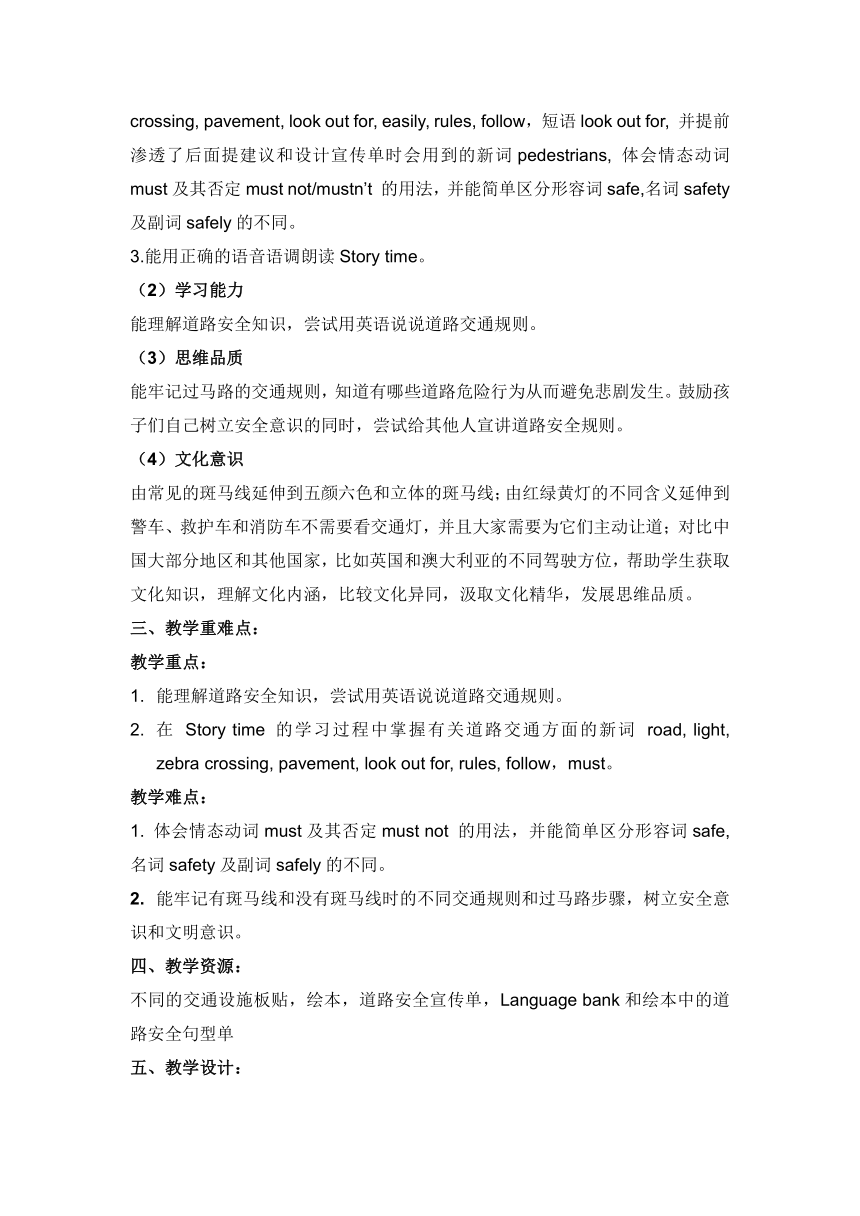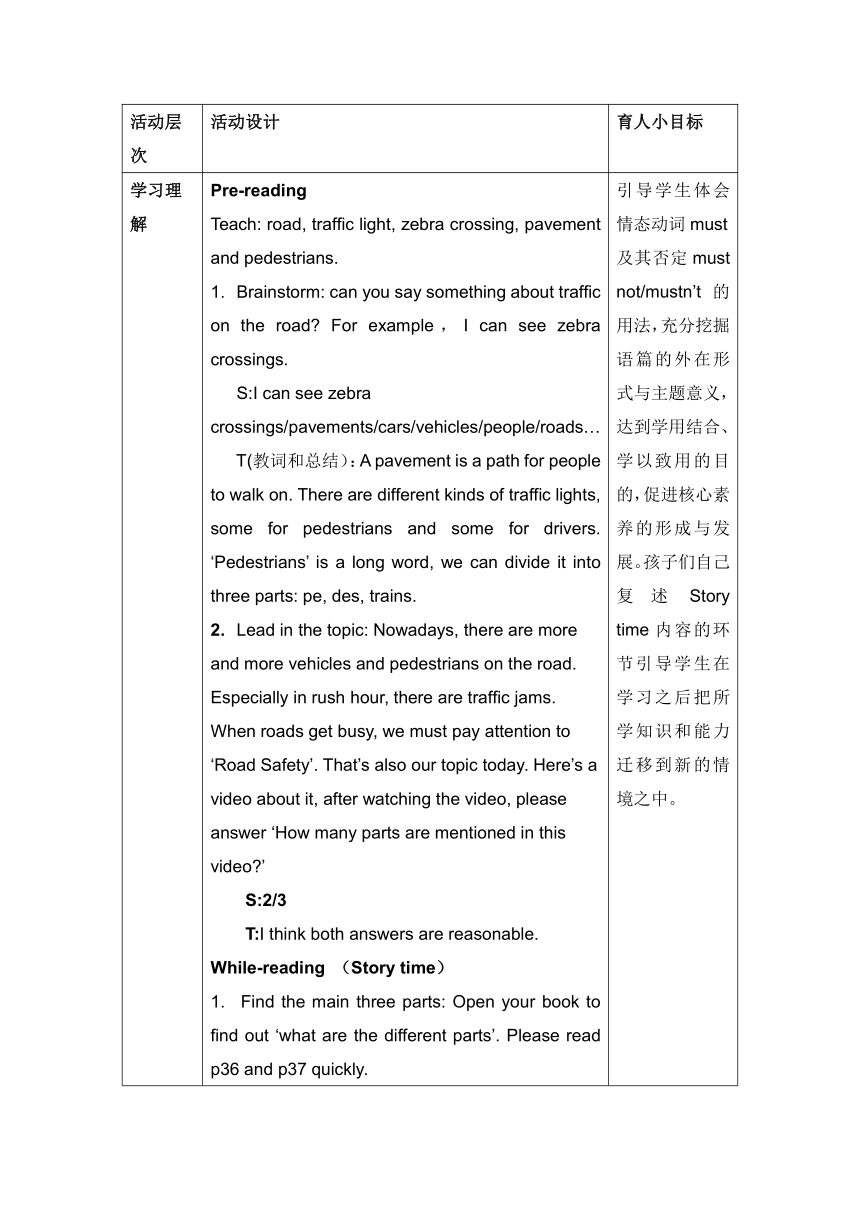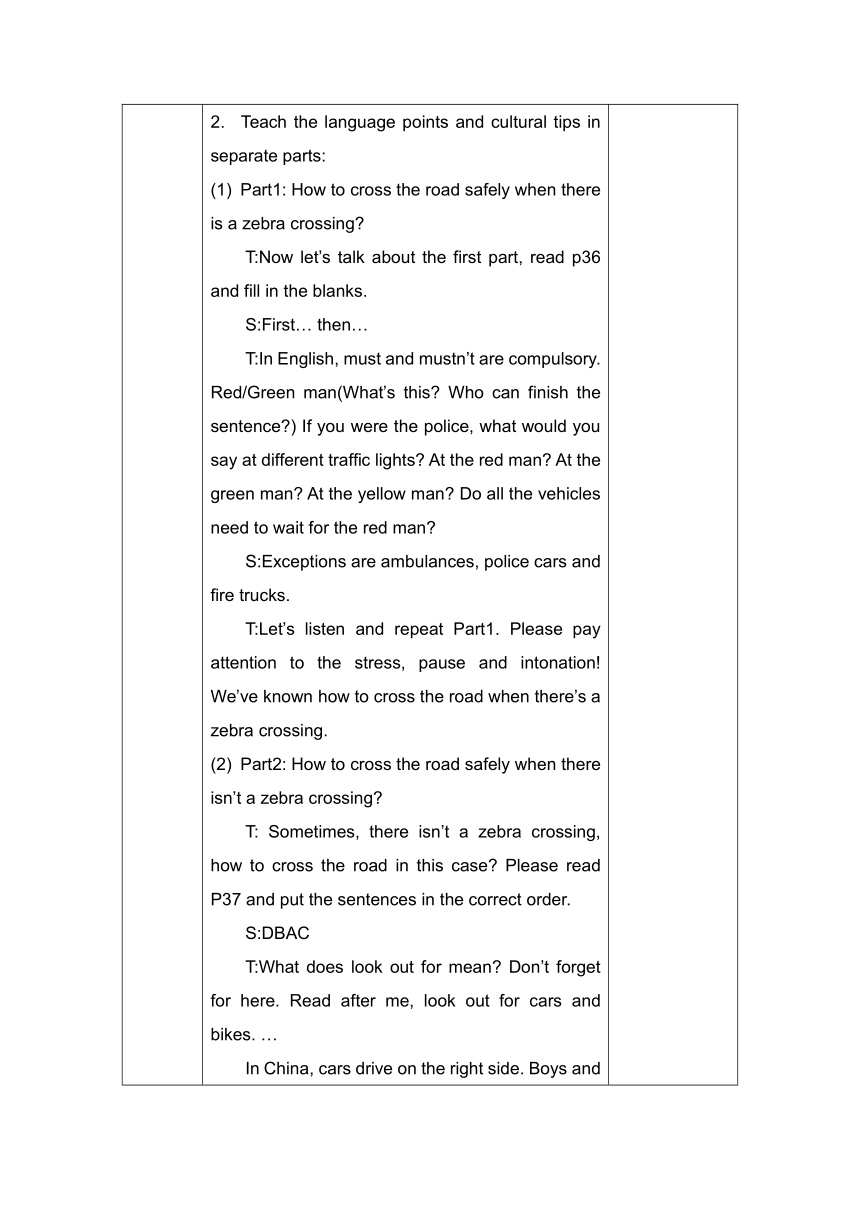Unit 4 Road safety Period 1表格式教案
文档属性
| 名称 | Unit 4 Road safety Period 1表格式教案 |  | |
| 格式 | docx | ||
| 文件大小 | 141.2KB | ||
| 资源类型 | 教案 | ||
| 版本资源 | 牛津译林版 | ||
| 科目 | 英语 | ||
| 更新时间 | 2023-10-10 15:11:47 | ||
图片预览




文档简介
6B Unit4 Road safety Period1
教学内容分析:
教学内容:Story time围绕“行路安全”这一话题,呈现了行人的行路规则和安全知识,旨在引导学生树立正确过马路和杜绝危险行为的安全意识。这一话题与学生的生活紧密相关,通过如何过马路的行为指南及车辆的行驶规则,在教学过程中呈现了情态动词must及其否定形式mustn’t的用法,在教学过程中联系生活实际,在给别人提建议的过程中反复使用相应句型,达到熟能生巧的目的,从而进行小组复述。学生总结这节课学到的生词、Story time和绘本中学到的安全规则,以及用You must/You mustn’t…来给出建议,从而引导孩子们给行人和司机给出建议,为最后的设计安全宣传单作铺垫。最后孩子们四人一组, 使用‘Story time’和绘本中的短语句型设计道路安全宣传单,小组上台展示宣传单并宣讲。
学情分析:1. “行路安全”这一话题贴合学生的生活实际,也是非常重要的一个内容。学生对过马路的交通规则、红绿等的具体含义以及车辆的行驶规则已有一定的知识经验基础。2. 本课所重点学习的情态动词must及其否定形式mustn’t可以结合六年级上册的Unit5,Unit6,Unit7中的can\should等情态动词来进行关于规定和规则的表达。
育人内涵:对Story time文本的解读以语篇为基础,围绕语篇的主题意义,通过学习理解、应用实践和迁移创新等一系列活动,学习和运用语言知识和语言技能。然后从Story time中行人的道路安全规则和危险道路行为关联到孩子们读过的‘The Dangerous Road Game’绘本,寻找书中更多的道路安全规则。再延伸到现实生活中真实的交通事故数据和电影“流浪地球”中广为流传的台词,并将课本和绘本中学到的道路安全短语和句型运用到道路安全宣传单的制作。这节课旨在指引孩子们做遵守交通规则的社会公民,并向身边人宣传交通安全规则和相关知识。
教学目标:
语言知识与语言能力
1.在情景中整体理解Story time的内容,找出文章的不同组成部分,概括每个部分的大意。
2.在Story time 的学习过程中掌握有关道路交通方面的新词 road, light, zebra crossing, pavement, look out for, easily, rules, follow,短语look out for, 并提前渗透了后面提建议和设计宣传单时会用到的新词pedestrians, 体会情态动词must及其否定must not/mustn’t 的用法,并能简单区分形容词safe,名词safety及副词safely的不同。
3.能用正确的语音语调朗读Story time。
学习能力
能理解道路安全知识,尝试用英语说说道路交通规则。
思维品质
能牢记过马路的交通规则,知道有哪些道路危险行为从而避免悲剧发生。鼓励孩子们自己树立安全意识的同时,尝试给其他人宣讲道路安全规则。
文化意识
由常见的斑马线延伸到五颜六色和立体的斑马线;由红绿黄灯的不同含义延伸到警车、救护车和消防车不需要看交通灯,并且大家需要为它们主动让道;对比中国大部分地区和其他国家,比如英国和澳大利亚的不同驾驶方位,帮助学生获取文化知识,理解文化内涵,比较文化异同,汲取文化精华,发展思维品质。
教学重难点:
教学重点:
能理解道路安全知识,尝试用英语说说道路交通规则。
在 Story time 的学习过程中掌握有关道路交通方面的新词 road, light, zebra crossing, pavement, look out for, rules, follow,must。
教学难点:
1. 体会情态动词must及其否定must not 的用法,并能简单区分形容词safe,名词safety及副词safely的不同。
能牢记有斑马线和没有斑马线时的不同交通规则和过马路步骤,树立安全意识和文明意识。
教学资源:
不同的交通设施板贴,绘本,道路安全宣传单,Language bank和绘本中的道路安全句型单
教学设计:
活动层次 活动设计 育人小目标
学习理解 Pre-reading Teach: road, traffic light, zebra crossing, pavement and pedestrians. Brainstorm: can you say something about traffic on the road For example,I can see zebra crossings. S:I can see zebra crossings/pavements/cars/vehicles/people/roads… T(教词和总结):A pavement is a path for people to walk on. There are different kinds of traffic lights, some for pedestrians and some for drivers. ‘Pedestrians’ is a long word, we can divide it into three parts: pe, des, trains. Lead in the topic: Nowadays, there are more and more vehicles and pedestrians on the road. Especially in rush hour, there are traffic jams. When roads get busy, we must pay attention to ‘Road Safety’. That’s also our topic today. Here’s a video about it, after watching the video, please answer ‘How many parts are mentioned in this video ’ S:2/3 T:I think both answers are reasonable. While-reading (Story time) Find the main three parts: Open your book to find out ‘what are the different parts’. Please read p36 and p37 quickly. Teach the language points and cultural tips in separate parts: Part1: How to cross the road safely when there is a zebra crossing T:Now let’s talk about the first part, read p36 and fill in the blanks. S:First… then… T:In English, must and mustn’t are compulsory. Red/Green man(What’s this Who can finish the sentence ) If you were the police, what would you say at different traffic lights At the red man At the green man At the yellow man Do all the vehicles need to wait for the red man S:Exceptions are ambulances, police cars and fire trucks. T:Let’s listen and repeat Part1. Please pay attention to the stress, pause and intonation! We’ve known how to cross the road when there’s a zebra crossing. Part2: How to cross the road safely when there isn’t a zebra crossing T: Sometimes, there isn’t a zebra crossing, how to cross the road in this case Please read P37 and put the sentences in the correct order. S:DBAC T:What does look out for mean Don’t forget for here. Read after me, look out for cars and bikes. … In China, cars drive on the right side. Boys and girls, let’s stand up and cross the road together…But things are different in the UK, look at the picture, what’s the difference Let’s try to say it together. Looking left and right can help us stay safe, why can we also cross with other people Let’s listen and repeat Part2. Part3:What must we not do on the road You know how to cross the road safely, but these children don’t. What are they doing now (What are they playing ) It’s not …Because… S:It’s not safe because there are many cars and bikes. T: Can you give them some advice S:You mustn’t… T: Just knowing these rules is not enough, we must … S: Follow the rules and stay safe on the road! T: Let’s listen and repeat Part3. 引导学生体会情态动词must及其否定must not/mustn’t 的用法,充分挖掘语篇的外在形式与主题意义,达到学用结合、学以致用的目的,促进核心素养的形成与发展。孩子们自己复述Story time内容的环节引导学生在学习之后把所学知识和能力迁移到新的情境之中。
应用实践 Post-reading Let’s show: Encourage students to retell the road safety rules in Story time. We’ve known how to cross the road safely and what we mustn’t do on the road. Let’s show the rules by yourselves! Four of you make a group, close your book, you can refer to or move the blackboard writing and describe the rules you’ve learned today. You can show together or one by one. For example, (please come and be my partner! Please face the audience. You say the first sentence please.) What have you learned today S:Different traffic words/road safety rules/dangerous road behaviors/how to cross the road safely… 让孩子们体会警察的工作情境体现出语言活动的主体是学生,语言学习活动的过程是学生发现、获取、概括和探究意义的过程。引领孩子们模拟过马路的同时帮助孩子们在真实情境中理解语言和文化内涵,强调在情境和问题中运用所学知识解决问题的重要性,也体现了循序渐进的语言学习理念。
迁移创新 Consolidation and extension Picture book ‘The Dangerous Road Game’: Do you remember the picture book we read before Can you find more road safety rules in it Please work in 4 and discuss. Road safety is never a game and not everyone is as lucky as Harey. Can you guess how many people died from traffic accidents in China last year Over sixty-one thousand. How many people got hurt Over two hundred and fifty thousand. It’s really important to follow the rules and avoid tragedies like these. Just as the popular saying in the movie the Wandering Earth goes: On countless ahead… S: Road safety comes first! 4.We can also use what we’ve learned today to remind others to follow traffic rules. What can you say to pedestrians What can you say to drivers Now it’s your turn to work in 4, design the leaflet together. You can use phrases and sentences from Story time and the picture book. After 5mins, please show your leaflet here and promote road safety rules to us, better with movements! Homework Read Story time fluently and try to recite. As Safety Guards, show your leaflet to family members and other students in Zhiyuan, and promote safety rules to them. Optional: 1.Scan the code to learn more traffic rules 2.Find out more traffic differences between China and other countries. 这些活动符合学生的认知特点,以核心素养为主要维度,围绕主题意义,通过感知、模仿、观察、思考、交流和展示等活动,让学生感受英语学习的乐趣。从Story time中行人的道路安全规则和危险道路行为关联到孩子们读过的绘本,寻找书中更多的道路安全规则。再延伸到现实生活中真实的交通事故数据和电影“流浪地球”中广为流传的台词,并将课本和绘本中学到的道路安全短语和句型运用到道路安全宣传单的制作。践行学思结合、用创为本的英语学习活动观。
语篇育人目标 通过如何过马路的行为指南及车辆的行驶规则,在教学过程中呈现了情态动词must及其否定形式mustn’t的用法,在教学过程中联系生活实际,引导学生在给别人提建议的过程中反复使用相应句型,进而开展小组复述活动。提高学生在运用语言和非语言知识以及各种策略,参与特定情境下相关主题的语言活动时所表达出来的语言理解和表达能力。帮助学生牢记有斑马线和没有斑马线时的不同交通规则和过马路步骤,树立安全意识和文明意识。很多问题没有特定答案,鼓励学生提出自己的想法,从而提高学生的思辨能力和思维品质。
六、板书设计:
教学反思:
从Story time中行人的道路安全规则和危险道路行为关联到孩子们读过的‘The Dangerous Road Game’绘本,寻找书中更多的道路安全规则,为学科育人提供话题和语境。再延伸到现实生活中真实的交通事故数据和电影“流浪地球”中广为流传的台词,并将课本和绘本中学到的道路安全短语和句型运用到道路安全宣传单的制作。整节课也贯穿了很多文化知识:由常见的斑马线延伸到五颜六色和立体的斑马线;由红绿黄灯的不同含义延伸到警车、救护车和消防车不需要看交通灯,并且大家需要为它们主动让道;对比中国大部分地区和其他国家,比如英国和澳大利亚的不同驾驶方位。这些语言实践活动帮助学生小组合作交流、共同探索和解决问题,学会倾听与分享、发展情感态度和价值观,在学习语言的同时养成积极乐观、健康良好的情感态度,尊重他人、宽和待人的道德品质,以及遵守规则、团结合作的公民素养。鼓励孩子们自己树立安全意识的同时,尝试给其他人宣讲道路安全规则。使学生在探究中走进文本,在情境中超越文本走进生活,从而培养学生积极的情感、态度、价值观,实现学科育人价值。
教学内容分析:
教学内容:Story time围绕“行路安全”这一话题,呈现了行人的行路规则和安全知识,旨在引导学生树立正确过马路和杜绝危险行为的安全意识。这一话题与学生的生活紧密相关,通过如何过马路的行为指南及车辆的行驶规则,在教学过程中呈现了情态动词must及其否定形式mustn’t的用法,在教学过程中联系生活实际,在给别人提建议的过程中反复使用相应句型,达到熟能生巧的目的,从而进行小组复述。学生总结这节课学到的生词、Story time和绘本中学到的安全规则,以及用You must/You mustn’t…来给出建议,从而引导孩子们给行人和司机给出建议,为最后的设计安全宣传单作铺垫。最后孩子们四人一组, 使用‘Story time’和绘本中的短语句型设计道路安全宣传单,小组上台展示宣传单并宣讲。
学情分析:1. “行路安全”这一话题贴合学生的生活实际,也是非常重要的一个内容。学生对过马路的交通规则、红绿等的具体含义以及车辆的行驶规则已有一定的知识经验基础。2. 本课所重点学习的情态动词must及其否定形式mustn’t可以结合六年级上册的Unit5,Unit6,Unit7中的can\should等情态动词来进行关于规定和规则的表达。
育人内涵:对Story time文本的解读以语篇为基础,围绕语篇的主题意义,通过学习理解、应用实践和迁移创新等一系列活动,学习和运用语言知识和语言技能。然后从Story time中行人的道路安全规则和危险道路行为关联到孩子们读过的‘The Dangerous Road Game’绘本,寻找书中更多的道路安全规则。再延伸到现实生活中真实的交通事故数据和电影“流浪地球”中广为流传的台词,并将课本和绘本中学到的道路安全短语和句型运用到道路安全宣传单的制作。这节课旨在指引孩子们做遵守交通规则的社会公民,并向身边人宣传交通安全规则和相关知识。
教学目标:
语言知识与语言能力
1.在情景中整体理解Story time的内容,找出文章的不同组成部分,概括每个部分的大意。
2.在Story time 的学习过程中掌握有关道路交通方面的新词 road, light, zebra crossing, pavement, look out for, easily, rules, follow,短语look out for, 并提前渗透了后面提建议和设计宣传单时会用到的新词pedestrians, 体会情态动词must及其否定must not/mustn’t 的用法,并能简单区分形容词safe,名词safety及副词safely的不同。
3.能用正确的语音语调朗读Story time。
学习能力
能理解道路安全知识,尝试用英语说说道路交通规则。
思维品质
能牢记过马路的交通规则,知道有哪些道路危险行为从而避免悲剧发生。鼓励孩子们自己树立安全意识的同时,尝试给其他人宣讲道路安全规则。
文化意识
由常见的斑马线延伸到五颜六色和立体的斑马线;由红绿黄灯的不同含义延伸到警车、救护车和消防车不需要看交通灯,并且大家需要为它们主动让道;对比中国大部分地区和其他国家,比如英国和澳大利亚的不同驾驶方位,帮助学生获取文化知识,理解文化内涵,比较文化异同,汲取文化精华,发展思维品质。
教学重难点:
教学重点:
能理解道路安全知识,尝试用英语说说道路交通规则。
在 Story time 的学习过程中掌握有关道路交通方面的新词 road, light, zebra crossing, pavement, look out for, rules, follow,must。
教学难点:
1. 体会情态动词must及其否定must not 的用法,并能简单区分形容词safe,名词safety及副词safely的不同。
能牢记有斑马线和没有斑马线时的不同交通规则和过马路步骤,树立安全意识和文明意识。
教学资源:
不同的交通设施板贴,绘本,道路安全宣传单,Language bank和绘本中的道路安全句型单
教学设计:
活动层次 活动设计 育人小目标
学习理解 Pre-reading Teach: road, traffic light, zebra crossing, pavement and pedestrians. Brainstorm: can you say something about traffic on the road For example,I can see zebra crossings. S:I can see zebra crossings/pavements/cars/vehicles/people/roads… T(教词和总结):A pavement is a path for people to walk on. There are different kinds of traffic lights, some for pedestrians and some for drivers. ‘Pedestrians’ is a long word, we can divide it into three parts: pe, des, trains. Lead in the topic: Nowadays, there are more and more vehicles and pedestrians on the road. Especially in rush hour, there are traffic jams. When roads get busy, we must pay attention to ‘Road Safety’. That’s also our topic today. Here’s a video about it, after watching the video, please answer ‘How many parts are mentioned in this video ’ S:2/3 T:I think both answers are reasonable. While-reading (Story time) Find the main three parts: Open your book to find out ‘what are the different parts’. Please read p36 and p37 quickly. Teach the language points and cultural tips in separate parts: Part1: How to cross the road safely when there is a zebra crossing T:Now let’s talk about the first part, read p36 and fill in the blanks. S:First… then… T:In English, must and mustn’t are compulsory. Red/Green man(What’s this Who can finish the sentence ) If you were the police, what would you say at different traffic lights At the red man At the green man At the yellow man Do all the vehicles need to wait for the red man S:Exceptions are ambulances, police cars and fire trucks. T:Let’s listen and repeat Part1. Please pay attention to the stress, pause and intonation! We’ve known how to cross the road when there’s a zebra crossing. Part2: How to cross the road safely when there isn’t a zebra crossing T: Sometimes, there isn’t a zebra crossing, how to cross the road in this case Please read P37 and put the sentences in the correct order. S:DBAC T:What does look out for mean Don’t forget for here. Read after me, look out for cars and bikes. … In China, cars drive on the right side. Boys and girls, let’s stand up and cross the road together…But things are different in the UK, look at the picture, what’s the difference Let’s try to say it together. Looking left and right can help us stay safe, why can we also cross with other people Let’s listen and repeat Part2. Part3:What must we not do on the road You know how to cross the road safely, but these children don’t. What are they doing now (What are they playing ) It’s not …Because… S:It’s not safe because there are many cars and bikes. T: Can you give them some advice S:You mustn’t… T: Just knowing these rules is not enough, we must … S: Follow the rules and stay safe on the road! T: Let’s listen and repeat Part3. 引导学生体会情态动词must及其否定must not/mustn’t 的用法,充分挖掘语篇的外在形式与主题意义,达到学用结合、学以致用的目的,促进核心素养的形成与发展。孩子们自己复述Story time内容的环节引导学生在学习之后把所学知识和能力迁移到新的情境之中。
应用实践 Post-reading Let’s show: Encourage students to retell the road safety rules in Story time. We’ve known how to cross the road safely and what we mustn’t do on the road. Let’s show the rules by yourselves! Four of you make a group, close your book, you can refer to or move the blackboard writing and describe the rules you’ve learned today. You can show together or one by one. For example, (please come and be my partner! Please face the audience. You say the first sentence please.) What have you learned today S:Different traffic words/road safety rules/dangerous road behaviors/how to cross the road safely… 让孩子们体会警察的工作情境体现出语言活动的主体是学生,语言学习活动的过程是学生发现、获取、概括和探究意义的过程。引领孩子们模拟过马路的同时帮助孩子们在真实情境中理解语言和文化内涵,强调在情境和问题中运用所学知识解决问题的重要性,也体现了循序渐进的语言学习理念。
迁移创新 Consolidation and extension Picture book ‘The Dangerous Road Game’: Do you remember the picture book we read before Can you find more road safety rules in it Please work in 4 and discuss. Road safety is never a game and not everyone is as lucky as Harey. Can you guess how many people died from traffic accidents in China last year Over sixty-one thousand. How many people got hurt Over two hundred and fifty thousand. It’s really important to follow the rules and avoid tragedies like these. Just as the popular saying in the movie the Wandering Earth goes: On countless ahead… S: Road safety comes first! 4.We can also use what we’ve learned today to remind others to follow traffic rules. What can you say to pedestrians What can you say to drivers Now it’s your turn to work in 4, design the leaflet together. You can use phrases and sentences from Story time and the picture book. After 5mins, please show your leaflet here and promote road safety rules to us, better with movements! Homework Read Story time fluently and try to recite. As Safety Guards, show your leaflet to family members and other students in Zhiyuan, and promote safety rules to them. Optional: 1.Scan the code to learn more traffic rules 2.Find out more traffic differences between China and other countries. 这些活动符合学生的认知特点,以核心素养为主要维度,围绕主题意义,通过感知、模仿、观察、思考、交流和展示等活动,让学生感受英语学习的乐趣。从Story time中行人的道路安全规则和危险道路行为关联到孩子们读过的绘本,寻找书中更多的道路安全规则。再延伸到现实生活中真实的交通事故数据和电影“流浪地球”中广为流传的台词,并将课本和绘本中学到的道路安全短语和句型运用到道路安全宣传单的制作。践行学思结合、用创为本的英语学习活动观。
语篇育人目标 通过如何过马路的行为指南及车辆的行驶规则,在教学过程中呈现了情态动词must及其否定形式mustn’t的用法,在教学过程中联系生活实际,引导学生在给别人提建议的过程中反复使用相应句型,进而开展小组复述活动。提高学生在运用语言和非语言知识以及各种策略,参与特定情境下相关主题的语言活动时所表达出来的语言理解和表达能力。帮助学生牢记有斑马线和没有斑马线时的不同交通规则和过马路步骤,树立安全意识和文明意识。很多问题没有特定答案,鼓励学生提出自己的想法,从而提高学生的思辨能力和思维品质。
六、板书设计:
教学反思:
从Story time中行人的道路安全规则和危险道路行为关联到孩子们读过的‘The Dangerous Road Game’绘本,寻找书中更多的道路安全规则,为学科育人提供话题和语境。再延伸到现实生活中真实的交通事故数据和电影“流浪地球”中广为流传的台词,并将课本和绘本中学到的道路安全短语和句型运用到道路安全宣传单的制作。整节课也贯穿了很多文化知识:由常见的斑马线延伸到五颜六色和立体的斑马线;由红绿黄灯的不同含义延伸到警车、救护车和消防车不需要看交通灯,并且大家需要为它们主动让道;对比中国大部分地区和其他国家,比如英国和澳大利亚的不同驾驶方位。这些语言实践活动帮助学生小组合作交流、共同探索和解决问题,学会倾听与分享、发展情感态度和价值观,在学习语言的同时养成积极乐观、健康良好的情感态度,尊重他人、宽和待人的道德品质,以及遵守规则、团结合作的公民素养。鼓励孩子们自己树立安全意识的同时,尝试给其他人宣讲道路安全规则。使学生在探究中走进文本,在情境中超越文本走进生活,从而培养学生积极的情感、态度、价值观,实现学科育人价值。
